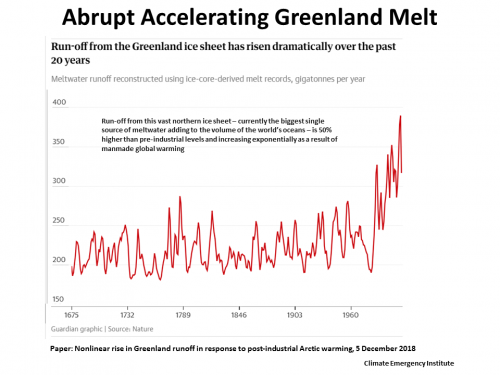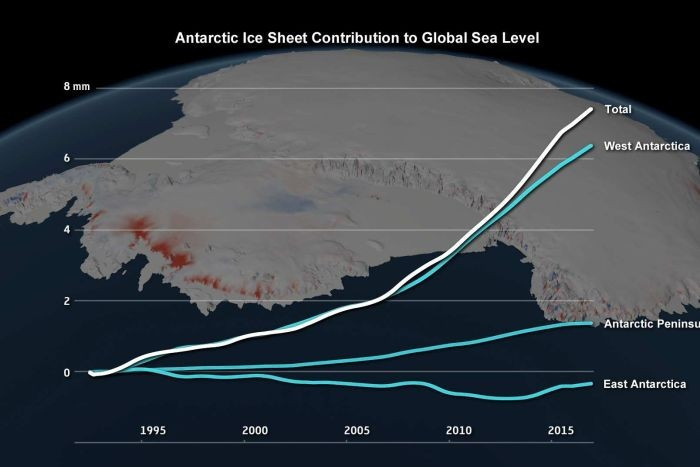Greenland and Antarctic Ice sheets
Latest Research Greenland
5 December 2018, Nature, L. Trusel, Nonlinear rise in Greenland runoff in response to post-industrial Arctic warming "Owing to a nonlinear response of surface melting to increasing summer air temperatures, continued atmospheric warming will lead to rapid increases in GrIS runoff and sea-level contributions".The melt is accelerating.
The biggest effect of global warming that is
most often referred to by scientists as our
biggest climate change issue is the change
in the state of the Greenland ice sheet, whereby
its instability and enormous size makes its
total loss slipping into the sea unstoppable
and irreversible. The result is a large rise
in coastal sea levels.
Because of the extremely long time frames involved in this change it is not a global existential threat, but it is for small island states, and with with every new research finding the time frame is diminishing.
While complete loss of all ice in Greenland is judged to be extremely unlikely during this century, the melting is accelerating, with a record extent of surface melting in the past decade.
Sept 2014 Greenland Ice Sheet more vulnerable to climate changethan previously thought
A new study finds that the Greenland Ice Sheet, which covers 1.7 million square kilometers and contains enough ice to raise sea levels worldwide by seven meters, is less stable and more sensitive to climate change than previously thought.
The Greenland Ice Sheet, which is the second-largest ice sheet in the world, covers 1.7 million square kilometres -- an area roughly eight times the size of the United Kingdom -- and contains enough ice to raise sea levels by more than seven metres if it were to be lost altogether.
Currently, due to surface melting alone, it is losing ice at a net annual rate of 200 gigatonnes, equating to 0.6 millimetres of sea level rise.
Large ice sheets such as in Greenland are far from stationary. Different parts of the ice often move at different speeds, causing ice to shear, a phenomenon known as ice flow.
"When these large ice sheets melt, whether that's due to seasonal change or a warming climate, they don't melt like an ice cube," said Dr Marion Bougamont of Cambridge's Scott Polar Research Institute, who led the research. "Instead, there are two sources of net ice loss: melting on the surface and increased flow of the ice itself, and there is a connection between these two mechanisms which we don't fully understand and isn't taken into account by standard ice sheet models."
Whereas other models of the Greenland Ice Sheet typically assume the ice slides over hard and impermeable bedrock -- an assumption which is largely practical and based on lack of constraints -- this study incorporates new evidence from ground-based surveys, which show soft and porous sediments at the bed of the ice sheet, more like the soft and muddy bottom of a lake than a sheet of solid rock. The new study specifically identifies the intake and temporal storage of water by weak sediment beneath the ice sheet as a crucial process in governing the ice flow.
1 August 2018, Earth and Planetary Science Letters, Louise Sandberg Sørensen, 25 years of elevation changes of the Greenland Ice Sheet from ERS, Envisat, and CryoSat-2 radar altimetry
A clear acceleration in thinning is evident in the 5-year maps of elevation following 2003, while only small elevation changes observed in the maps from the 1990s.
5 December 2018, Nature, L. Trusel, Nonlinear rise in Greenland runoff in response to post-industrial Arctic warming "Owing to a nonlinear response of surface melting to increasing summer air temperatures, continued atmospheric warming will lead to rapid increases in GrIS runoff and sea-level contributions".The melt is accelerating.
The biggest effect of global warming that is
most often referred to by scientists as our
biggest climate change issue is the change
in the state of the Greenland ice sheet, whereby
its instability and enormous size makes its
total loss slipping into the sea unstoppable
and irreversible. The result is a large rise
in coastal sea levels.
Because of the extremely long time frames involved in this change it is not a global existential threat, but it is for small island states, and with with every new research finding the time frame is diminishing.
While complete loss of all ice in Greenland is judged to be extremely unlikely during this century, the melting is accelerating, with a record extent of surface melting in the past decade.
Sept 2014 Greenland Ice Sheet more vulnerable to climate changethan previously thought
A new study finds that the Greenland Ice Sheet, which covers 1.7 million square kilometers and contains enough ice to raise sea levels worldwide by seven meters, is less stable and more sensitive to climate change than previously thought.
The Greenland Ice Sheet, which is the second-largest ice sheet in the world, covers 1.7 million square kilometres -- an area roughly eight times the size of the United Kingdom -- and contains enough ice to raise sea levels by more than seven metres if it were to be lost altogether.
Currently, due to surface melting alone, it is losing ice at a net annual rate of 200 gigatonnes, equating to 0.6 millimetres of sea level rise.
Large ice sheets such as in Greenland are far from stationary. Different parts of the ice often move at different speeds, causing ice to shear, a phenomenon known as ice flow.
"When these large ice sheets melt, whether that's due to seasonal change or a warming climate, they don't melt like an ice cube," said Dr Marion Bougamont of Cambridge's Scott Polar Research Institute, who led the research. "Instead, there are two sources of net ice loss: melting on the surface and increased flow of the ice itself, and there is a connection between these two mechanisms which we don't fully understand and isn't taken into account by standard ice sheet models."
Whereas other models of the Greenland Ice Sheet typically assume the ice slides over hard and impermeable bedrock -- an assumption which is largely practical and based on lack of constraints -- this study incorporates new evidence from ground-based surveys, which show soft and porous sediments at the bed of the ice sheet, more like the soft and muddy bottom of a lake than a sheet of solid rock. The new study specifically identifies the intake and temporal storage of water by weak sediment beneath the ice sheet as a crucial process in governing the ice flow.
1 August 2018, Earth and Planetary Science Letters, Louise Sandberg Sørensen, 25 years of elevation changes of the Greenland Ice Sheet from ERS, Envisat, and CryoSat-2 radar altimetry
A clear acceleration in thinning is evident in the 5-year maps of elevation following 2003, while only small elevation changes observed in the maps from the 1990s.

Antarctic Research
11 Dec 2018NASA detects Antarctic ice retreat in region once thought stable
Antarctic melt accelerating loss of mass has - tripled
Mass balance of the Antarctic Ice Sheet from 1992 to 2017, Nature, June 2018
11 Dec 2018NASA detects Antarctic ice retreat in region once thought stable
Antarctic melt accelerating loss of mass has - tripled
Mass balance of the Antarctic Ice Sheet from 1992 to 2017, Nature, June 2018

